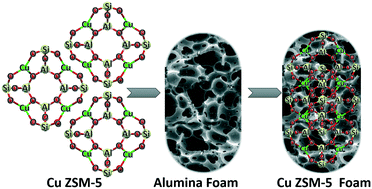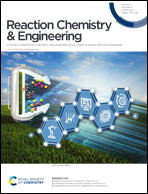Selective catalytic reduction of NO over hierarchical Cu ZSM-5 coated on an alumina foam support†
Abstract
The development of structured catalysts for process intensification is of growing interest in catalytic processes due to heat and mass transfer limitations at an industrial scale. These limitations can be diminished to an extent by the introduction of hierarchical foam catalysts. We develop a hierarchical Cu ZSM-5 catalyst coated on a macroporous α alumina foam support for NH3 selective catalytic reduction (SCR) of NO. This hierarchical Cu ZSM-5 catalyst along with the macroporous foam support enhances the mass transfer and increases the catalyst life with reduced pressure drop. The Cu ZSM-5 foam catalyst is synthesized by an in situ hydrothermal method with three different SiO2/Al2O3 ratios of 10, 20, and 50. The catalysts are characterized for their crystallinity, morphology, acidity, and redox properties. The standard SCR of NO by NH3 is carried out to determine the performance of the prepared Cu ZSM-5 foam catalysts. The NO conversion at low-temperature increases due to NO oxidation attributed to the CuO content in the foam catalyst. A high conversion of 96% is observed at 350 °C with a mass transfer coefficient of 0.1 m s−1 and pressure drop of 1.9 kPa at 55 200 h−1 over Cu ZSM-5-20. The NO conversion decreases at higher temperatures due to NH3 oxidation. The more or less steady NO conversion efficiency exhibited by the Cu ZSM-5-20 foam catalyst in the temperature range of 200 to 550 °C is advantageous in NO reduction from high-temperature exhaust gases.



 Please wait while we load your content...
Please wait while we load your content...